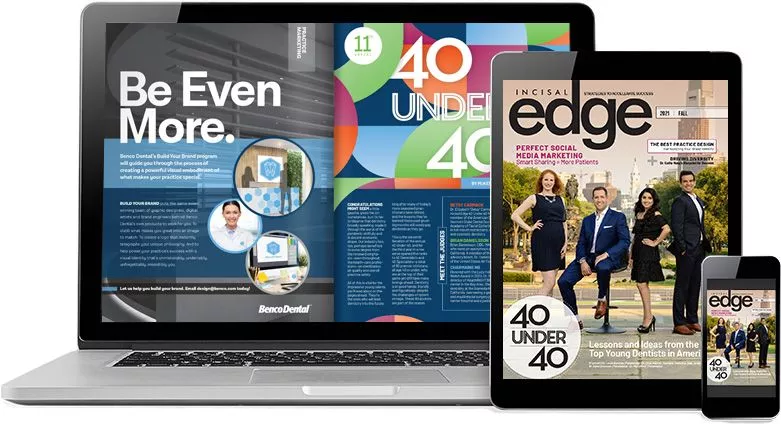By Jason H. Goodchild, DMD
Tooth preparation, both intracoronally typically for operative procedures, and extracoronally for crown and bridge procedures, requires a rotary cutting instrument. The two main rotary cutting instruments, known to dental professionals as burs, have cutting surfaces made up of tungsten carbide or diamond.
Despite early evidence demonstrating that the use of diamond burs for preparing teeth is associated with significantly less grinding energy compared to carbide burs, many clinicians still utilize carbide for simple operative procedures, perhaps unaware of the benefits of diamond burs.
In addition to the two main bur types, burs are also offered as either single-use or multiple-use. When burs are used multiple times, high-level sterilization as defined by the Centers for Disease Control and Prevention (CDC) is required. Even when burs are scrubbed and autoclaved, they are difficult to sterilize. The Occupational and Safety Administration (OSHA) recommends that since burs are difficult to clean and are degraded by the sterilization process, dental offices should consider making burs a single-use disposable item.
Other important factors to consider when selecting diamond burs are: bur longevity and the impact on tooth preparation, microleakage, and retention. Deciding when to change a bur is largely subjective for the clinician but may have significant impact on the tooth preparation and restorative procedures. Disposable burs should be discarded after each patient and should not be used for more than three preparations, and multiple-use burs must be sterilized after use and should be discarded after five preparations. Failure to change burs after the appropriate number of preparations has been shown to decrease the retention of copings, increase microleakage, and decrease overall bur performance. In a study by Kaviani and colleagues, the shear bond strength of self-etch adhesive performed significantly better when a diamond bur was used. Other studies confirm that bur grit can also impact marginal integrity, with fine and super fine grit performing best.
Premier Dental Products Company has introduced Solo Diamond® Single Patient-Use burs to help provide excellent rotary cutting instruments that are supplied pre-sterile in individual pouches. Solo Diamonds are available in 97 unique shapes, with 144 SKU’s total depending on bur grit (ranges from coarse to extra fine). Not only are there numerous crown and bridge shapes and sizes, Solo Diamonds also are available in the most popular operative shapes in medium grit: 330, 245, and 557. For both the crown and bridge shapes and the operative shapes, Solo Diamonds are made using precision-machined blanks with a high quality electroplating process to produce efficient grinding of tooth structure. Each bur is gamma-sterilized with a validated 5-year pouch seal integrity to reduce cross-contamination.
Case Example
A 52-year-old male patient presented for a full-coverage monolithic zirconia crown on tooth No. 4. The tooth had previously undergone root canal therapy and a post and core build-up.

Figure 1: Occlusal view of tooth No. 4 pre-operatively

Figure 2: Solo Diamond 847016C but for buccal and lingual reduction
The first step in preparation of tooth No. 4 for a zirconia crown is reduction of the clinical crown in the buccal and lingual dimensions. This was accomplished using a flat-ended taper diamond bur (Solo Diamond #847016C), to create rounded internal line angles. (Figure 2 and 3) Next, interproximal contacts are broken using a round end-taper diamond bur (Solo Diamond #850012C), followed by occlusal reduction and shaping using a football diamond bur (Solo Diamond #368T023C). (Figure 4) Proper axial reduction for a monolithic zirconia crown should be approximately 1.0mm with occlusal reduction of 1.0-1.5mm in the central fossa. This will provide the laboratory with adequate reduction to create sufficient thickness of material for strength and esthetics while allowing enough material for adjustment.

Figure 3: Buccal and lingual reduction of tooth No. 4

Figure 4: Occlusal reduction and shaping is accomplished with a football diamond

Figure 5: Final preparation of tooth No. 4 after placing a circumferential bevel with a fine grit flame diamond

Figure 6: Tissue management for tooth No. 4 is achieved using Traxodent gingival retraction paste and a Retraction Cap (Premier)

Figure 7: After tissue management and water rinsing, the tooth is ready for impressioning.

Figure 8: Final impression of tooth No. 4 with polyether impression material and T Loc Triple Tray (Premier)
For the final preparation step, a circumferential bevel for tooth No. 4 is created using a fine grit flame diamond (Solo #846KR016F). (Figure 5) The bevel adds 1–1.5mm of additional tooth. A smooth finish line and cavosurface are vital not only for precise fabrication of the final crown, but also help to prevent microleakage when using self-adhesive resin cementation.
Following careful inspection to verify adequate shape, taper, and reduction of tooth No. 4, tissue management is completed to create retraction, drying, and hemostasis prior to making a final impression. (Figures 6-8) Because burs are a contaminated sharp after use, at the conclusion of the procedure the Solo Diamonds were properly disposed of in a red sharps container.
REFERENCES:
- Cohen BD, Bowley JF, Sheridan PJ. An evaluation of operator preference of diamond burs in coronal tooth preparation. Compend Contin Educ Dent 1997;18(2):158-164.
- Sharon SC, Von Fraunhofer JA. Dental cutting: the historical development of diamond burs. J Am Dent Assoc 1998;129:740-745.
- Frequently Asked Questions (FAQs) on dental infection control. OSAP. Available at: https://www.osap.org/?FAQ_Instrum_Ster1#whataretheguidelines. Accessed May 2, 2018.
- Von Fraunhofer JA, Smith TA. The effect of multiple uses of disposable burs on restoration leakage. J Am Dent Assoc 2005;136:53-57.
- Emir F, Ayyildiz S, Sahin C, What is the changing frequency of diamond burs? J Adv Prosthodont 2018;10:93-100.
- Malekipour MR, Shirani F, Tahmourespour S. The effect of cutting efficacy of diamond burs on microleakage of Class V resin composite restorations using total etch and self etch adhesive systems. J Dent 2010;7(4):218-25.
- Siegel SC, Von Fraunhofer JA. Dental cutting with diamond burs: heavy-handed or light touch? J Prosthod 1999;8:3-9.
- Felton DA, Kanoy BE, White JT. The effect of surface roughness of crown preparations on retention of cemented castings. J Prosthet Dent 1987;58(3):292-6.
- Lise DP, Monteiro S, Gondo R. Influence of reused dental burs on bond strength to dentin. Journal of Research ion Dentistry 2014;2(3):235-242.
- Kaviani A, Ahmadzadeh A, Shahroie J, et al. Effects of diamond and carbide burs on dentin bond strengths of self-etch bonding systems. JIDAI 2013;25(2):57-61.
- Nishimura K, Ikeda M, Yoshikawa T, et al. Effect of various grit burs on marginal integrity of resin composite restorations. J Med Dent Sci 2005;52:9-15.
- Ermis RB, De Munck J, Cardoso MV, et al. Bond strength of self-etch adhesives to dentin prepared with three different diamond burs. Dent Mater 2008;24(7):978-85.
ACKNOWLEDGEMENT:
Clinical imagery for this case courtesy of Shalom Mehler, DMD
 Jason H. Goodchild, DMD received his undergraduate degree from Dickson College in Carlisle, Pennsylvania. He went on to receive his dental training at the University Of Pennsylvania School Of Dental Medicine (Philadelphia, PA). He is currently the Director of Clinical Affairs at Premier Dental Products Company (Plymouth Meeting, PA) involved in developing innovative new products and educating to improve clinical practice. He is also Associate Clinical Professor in the Department of Diagnostic Sciences at Creighton University School of Dentistry (Omaha, NE), and Adjunct Assistant Professor in the Department of Diagnostic Sciences at the Rutgers School of Dental Medicine (Newark, NJ).
Jason H. Goodchild, DMD received his undergraduate degree from Dickson College in Carlisle, Pennsylvania. He went on to receive his dental training at the University Of Pennsylvania School Of Dental Medicine (Philadelphia, PA). He is currently the Director of Clinical Affairs at Premier Dental Products Company (Plymouth Meeting, PA) involved in developing innovative new products and educating to improve clinical practice. He is also Associate Clinical Professor in the Department of Diagnostic Sciences at Creighton University School of Dentistry (Omaha, NE), and Adjunct Assistant Professor in the Department of Diagnostic Sciences at the Rutgers School of Dental Medicine (Newark, NJ).


